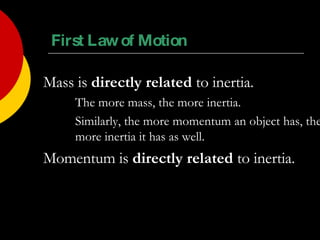Inertia 5
- 1. Originally, Sir Isaac Newton attempted to explain the first law of motion as product of the mechanics of inertia. As time prevailed and science evolved, the theory switched to say that inertia does not constitute the mechanics behind the phenomenon of the first law of motion, but rather that inertia IS the phenomenon described in the first law of motion. Where the law itself and inertia used to be two different things, today, the ideas are one of the same.
- 2. First Law of Motion Objects in motion will stay in motion, at the same speed, in the same direction, until acted upon by an unbalanced force. Similarly, objects that are at rest, will stay at rest until they are acted upon by an unbalanced force.
- 3. Imagine you have a full cup of coffee in your hand, and you try and walk a lap around a track as quickly as possible. When will the coffee spill over the edge? When you start moving. When you stop moving. When/if you change direction with the track. All of these times are examples of an unbalanced force acting upon the coffee cup…and when the force is unbalanced, the coffee will not remain at its constant velocity (which ideally would be zero).
- 4. An object with a net force of zero, will move at CONSTANT velocity. “ An object in motion will stay in motion.” Velocity Time Note: Velocity can be anything, including zero. If an object is at rest, it will remain at rest until an unbalanced force acts upon it.
- 5. The first law refers to constant velocity, NOT constant acceleration. Velocity Time
- 6. First Law of Motion Mass is directly related to inertia. The more mass, the more inertia. Similarly, the more momentum an object has, the more inertia it has as well. Momentum is directly related to inertia.
- 7. F=ma Force applied Mass Acceleration This formula explains that the greater the mass, the less the object will accelerate under a given force. The less the mass, the faster the object will accelerate under a given force. Therefore, it takes less energy to move a smaller mass than it takes to move a larger mass.
- 8. This makes sense… On the table, there is a textbook and a piece of paper. The piece of paper is much easier to move across the table than the textbook. It requires less force, because it has less mass.
- 9. The force needed to keep an object moving at constant velocity, is ALWAYS less than the force needed to move the object from rest to moving, or to change the acceleration from the initial velocity to the final.








